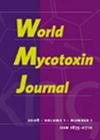Effect of cleaning, milling, and cooking on the reduction of deoxynivalenol in freshly harvested rice
IF 1.7
4区 医学
Q3 FOOD SCIENCE & TECHNOLOGY
引用次数: 0
Abstract
Fusarium mycotoxins were frequently present in freshly harvested rice samples caused by Fusarium head blight in China recently. Due to the importance of rice and the risks associated with mycotoxins, the fate of Fusarium mycotoxins in rice was evaluated by physical methods. In the present study, a total of 157 freshly harvested rice samples were collected from fields in Jiangsu Province. Mycotoxin analysis showed that only Fusarium mycotoxins were found in these samples, with deoxynivalenol (DON) being the major mycotoxin. Twenty-three freshly harvested rice samples containing concentrations of DON higher than 200 μg/kg were selected for cleaning and milling. Compared with air or gravity separation, the combined air and gravity separation was the most effective cleaning method to decrease the content of DON. After milling, brown and white rice intended for human consumption presented lower level of DON than freshly harvested rice, husks, and bran. Three types of brown and white rice with different contents of DON were chosen for cooking. Compared with other treatments, preboiled was the most effective method to reduce DON in both brown and white rice. The results of this study improve our understanding of the transfer ratios of DON and the development of effective control measures during the postharvest stage.清洗、碾磨和烹饪对降低新收获稻米中脱氧雪腐镰刀菌烯醇含量的影响
最近,在中国,由镰刀菌纹枯病引起的新收获稻米样品中经常出现镰刀菌霉菌毒素。鉴于水稻的重要性和霉菌毒素带来的风险,研究人员采用物理方法对水稻中镰刀霉菌毒素的去向进行了评估。本研究从江苏省的稻田中采集了 157 份新收割的水稻样本。霉菌毒素分析表明,这些样品中只发现了镰刀菌霉菌毒素,其中主要的霉菌毒素是脱氧雪腐镰刀菌烯醇(DON)。研究人员选取了 23 个 DON 含量高于 200 μg/kg 的新收获大米样品进行清洗和碾磨。与空气分离或重力分离相比,空气和重力联合分离是降低 DON 含量最有效的清洗方法。碾米后,供人类食用的糙米和白米的 DON 含量低于新收获的大米、谷壳和谷糠。我们选择了三种 DON 含量不同的糙米和白米进行烹饪。与其他处理方法相比,预煮是降低糙米和白米中 DON 含量的最有效方法。这项研究的结果加深了我们对 DON 转移比率的了解,有助于在收获后阶段制定有效的控制措施。
本文章由计算机程序翻译,如有差异,请以英文原文为准。
求助全文
约1分钟内获得全文
求助全文
来源期刊

World Mycotoxin Journal
MYCOLOGY-
CiteScore
4.60
自引率
5.00%
发文量
25
审稿时长
>12 weeks
期刊介绍:
''World Mycotoxin Journal'' is a peer-reviewed scientific journal with only one specific area of focus: the promotion of the science of mycotoxins. The journal contains original research papers and critical reviews in all areas dealing with mycotoxins, together with opinions, a calendar of forthcoming mycotoxin-related events and book reviews. The journal takes a multidisciplinary approach, and it focuses on a broad spectrum of issues, including toxicology, risk assessment, worldwide occurrence, modelling and prediction of toxin formation, genomics, molecular biology for control of mycotoxigenic fungi, pre-and post-harvest prevention and control, sampling, analytical methodology and quality assurance, food technology, economics and regulatory issues. ''World Mycotoxin Journal'' is intended to serve the needs of researchers and professionals from the scientific community and industry, as well as of policy makers and regulators.
 求助内容:
求助内容: 应助结果提醒方式:
应助结果提醒方式:


